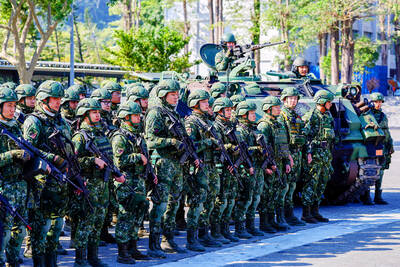A university student has gained the spotlight for an interactive map he designed detailing all of China’s military bases and installations throughout the Indo-Pacific region.
Soochow University music student Joseph Wen (溫約瑟), who calls himself an amateur military enthusiast, said he created the map to “help people better understand the cross-strait situation.”
Wen originally posted the map online on June 14 last year, but it gained greater attention after he mentioned it during an appearance on a China Television talk show.

Photo: Screen grab from Web site
On the show, Wen said he had gathered information on the locations from publicly available Web sites, as well as academic papers from military academies in Taiwan and other countries.
For example, Wen said he learned about one base’s location after a user on Baidu posted about a reservoir next to a military camp.
Wen said he used maps to cross-reference and pinpoint the base’s location.
“Sometimes I simply pore over maps with the naked eye, but this can lead to mistakes,” he said, adding that he once mistook a prison for a military facility.
“Intelligence agencies have more accurate information, so this is just for public use,” he said.
Wen on Saturday said that following his appearance on the TV talk show, he received threatening Twitter messages about his map.
However, Wen added that he was not frightened by the messages, but would report the Internet users to the police if necessary.
Despite his enthusiasm for military affairs, Wen said he has no family members in the military.
His interest in the military developed in junior-high school through conversations with friends, he said.
After creating the map, Wen learned that what he has been doing is known as open-source intelligence analysis.
Wen said he plans to continue updating the map, but has no plans for a career in the military or in intelligence.
“Music is a relatively pure interest that is not shrouded in conflict, with the exception of some aspects of music history,” he said, adding that he prefers the simple pleasures of studying music.

UNILATERAL MOVES: Officials have raised concerns that Beijing could try to exert economic control over Kinmen in a key development plan next year The Civil Aviation Administration (CAA) yesterday said that China has so far failed to provide any information about a new airport expected to open next year that is less than 10km from a Taiwanese airport, raising flight safety concerns. Xiamen Xiangan International Airport is only about 3km at its closest point from the islands in Kinmen County — the scene of on-off fighting during the Cold War — and construction work can be seen and heard clearly from the Taiwan side. In a written statement sent to Reuters, the CAA said that airports close to each other need detailed advanced

Tropical Storm Fung-Wong would likely strengthen into a typhoon later today as it continues moving westward across the Pacific before heading in Taiwan’s direction next week, the Central Weather Administration (CWA) said. As of 8am, Fung-Wong was about 2,190km east-southeast of Cape Oluanpi (鵝鑾鼻), Taiwan’s southernmost point, moving westward at 25kph and possibly accelerating to 31kph, CWA data showed. The tropical storm is currently over waters east of the Philippines and still far from Taiwan, CWA forecaster Tseng Chao-cheng (曾昭誠) said, adding that it could likely strengthen into a typhoon later in the day. It is forecast to reach the South China Sea

WEATHER Typhoon forming: CWA A tropical depression is expected to form into a typhoon as early as today, the Central Weather Administration (CWA) said yesterday, adding that the storm’s path remains uncertain. Before the weekend, it would move toward the Philippines, the agency said. Some time around Monday next week, it might reach a turning point, either veering north toward waters east of Taiwan or continuing westward across the Philippines, the CWA said. Meanwhile, the eye of Typhoon Kalmaegi was 1,310km south-southeast of Oluanpi (鵝鑾鼻), Taiwan’s southernmost point, as of 2am yesterday, it said. The storm is forecast to move through central

Almost a quarter of volunteer soldiers who signed up from 2021 to last year have sought early discharge, the Legislative Yuan’s Budget Center said in a report. The report said that 12,884 of 52,674 people who volunteered in the period had sought an early exit from the military, returning NT$895.96 million (US$28.86 million) to the government. In 2021, there was a 105.34 percent rise in the volunteer recruitment rate, but the number has steadily declined since then, missing recruitment targets, the Chinese-language United Daily News said, citing the report. In 2021, only 521 volunteers dropped out of the military, the report said, citing